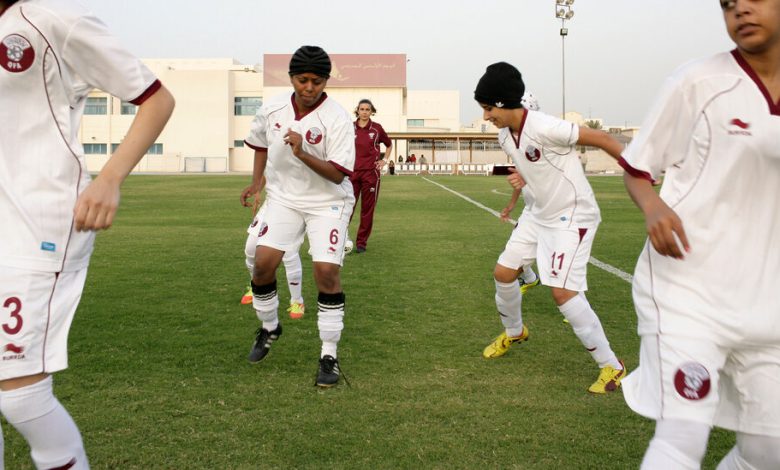What Happened to the Qatar Women’s National Team?

DOHA, Qatar — The last official soccer match that the Qatar women’s national team played was on April 19, 2014. Hagar Nader Nessim Aziz Saleh, who was only 15 years old at the time, can hardly remember it now. It was a little cold that day, she recalled, and Qatar was playing in Amman, Jordan, at the West Asian Football Federation Women’s Championship.
She remembered screaming and celebrating when Dana al-Jassim scored in extra time, in the 92nd minute, one of Qatar’s only goals of the tournament. Her team lost that day, 8-2. It has not played an official match since.
There have been some friendly matches and several cultural exchanges, including a visit from players on an American women’s team in 2020, and a trip to New York and San Francisco earlier this year to learn about women’s soccer in the United States. There are photos of the team, in maroon tracksuits and white jerseys with the official patch for the Q.F.A., the Qatar Football Association. But the jerseys are dated by the sponsor, Burrda, whose partnership with the soccer federation ended years ago.
Other than that, there is hardly any trace of a national women’s soccer team in Qatar, even as the country hosts the men’s World Cup. There is no mention of a women’s team on the Qatar Football Association website, and there is no team listed on the FIFA women’s rankings. There’s a Wikipedia page and a curious Instagram account called Women’s Football Qatar with 106 followers.
The World Cup in Qatar seemed a good chance to ask: Where did the team go?
Origins of a Team
In 2001, Sheikha Moza bint Nasser al-Missned — the wife of the emir at the time, and the mother of the current emir — established the Qatar Women’s Sport Committee to oversee all sports for women and girls. In 2009, the national women’s soccer team was created, just as Qatar was preparing its bid to host the 2022 World Cup.
A year later, and only weeks before FIFA was to choose the host of the 2022 World Cup, the women’s national team played its first-ever official match. It did not go well. Beaten by 17-0 by Bahrain at the Arabia Women’s Cup, the team went on to lose to Syria and Palestine in the same tournament, by double-digit scores each time. But there was a team and a record of its games.
A Brief Guide to the 2022 World Cup
What is the World Cup? The quadrennial event pits the best national soccer teams against each other for the title of world champion. Here’s a primer to the 2022 men’s tournament:
Where is it being held? This year’s host is Qatar, which in 2010 beat the United States and Japan to win the right to hold the tournament. Whether that was an honest competition remains in dispute.
When is it? The tournament opened on Nov. 20, when Qatar played Ecuador. Over the two weeks that follow, four games will be played on most days. The tournament ends with the final on Dec. 18.
Is a winter World Cup normal? No. The World Cup usually takes place in July. But in 2015, FIFA concluded that the summer temperatures in Qatar might have unpleasant consequences and agreed to move the tournament to the relatively bearable months of November and December.
How many teams are competing? Thirty-two. Qatar qualified automatically as the host, and after years of matches, the other 31 teams earned the right to come and play. Meet the teams here.
How does the tournament work? The 32 teams are divided into eight groups of four. In the opening stage, each team plays all the other teams in its group once. The top two finishers in each group advance to the round of 16. After that, the World Cup is a straight knockout tournament.
How can I watch the World Cup in the U.S.? The tournament will be broadcast on Fox and FS1 in English, and on Telemundo in Spanish. You can livestream it on Peacock, or on streaming services that carry Fox and FS1. Here’s how to watch every match.
When will the games take place? Qatar is three hours ahead of London, eight hours ahead of New York and 11 hours ahead of Los Angeles. That means there will be predawn kickoffs on the East Coast of the United States for some games, and midafternoon starts for 10 p.m. games in Qatar.
Got more questions? We’ve got more answers here.
A month and a half later, on Dec. 2, 2010, Sepp Blatter, then the president of FIFA, opened a small white envelope and declared Qatar the host of the 2022 World Cup.
FIFA does not require a host country to have both a men’s and women’s national team. FIFA’s 211 member associations also are not required to have both men’s and women’s national teams, and dozens of countries do not. But in FIFA’s 30-plus-page bid evaluation report of Qatar, in the section about developing the sport, Qatar outlined its commitment to the “promotion of women’s football, including creation of special facilities.”
Asked if the host country was following through on this promise, a spokesman for FIFA said, “We do not comment on the status of football development in individual countries or the situation of specific member associations.”
Qatar appears to have plans to follow through on at least one aspect: the facilities. Education City Stadium, one of the tournament’s venues, has been earmarked for women’s soccer after the World Cup ends. But the Aspire Academy, Qatar’s billion-dollar talent farming project, still does not have a women’s soccer program.
In fact, the development of women’s soccer in Qatar, at least as it relates to creating and developing a pipeline to the women’s national team, has been at a standstill for the last eight years — ever since Monika Staab left in 2014. Staab, a former player in Germany’s women’s Bundesliga in the late 1980s, has spent the past two decades developing women’s soccer in countries across the world. She coached the Qatar women’s national team from 2013 to 2014 and is now the coach of Saudi Arabia’s women’s team.
Staab said she left Qatar because the Women’s Sport Committee wanted a man as coach and someone who spoke Arabic, which she did not. She said in an interview that she did not know what happened to the national team after she left. It has still never won an official match, but under Staab’s two-year tenure the team posted some of its best results, 3-0 and 1-0 losses to the Maldives.
Staab, who has worked in more than 80 countries, said she was also reluctant to single-out Qatar for what she saw as a pervasive lack of support for women’s soccer.
“Lip service is something that happens in most of the countries I’ve been in,” she said. “When I go around now I say: ‘OK, there is a big piece of cake. I don’t mind that the men have most of the cake and that they know how the cake tastes. But we also want to know how the cake is. So give us just a quarter or something very little.’ We can do a lot with it because now we know how the cake tastes, and we can bake another one.”
A Squad in Limbo
Hagar Nader Nessim Aziz Saleh was the easiest player to find, through a tagged photo of her on the Women’s Football Qatar account on Instagram, and a message sent to her asking to meet. Before agreeing, she asked that the request first go through Abeer Ahmed al-Kuwari, the manager of the women’s national team and a member of the Qatar Women’s Sport Committee. Al-Kuwari agreed to arrange a meeting, and said she would bring Saleh and a few other players from the national team.
At the Tawar Mall, a small and dated strip mall about 20 minutes outside of downtown Doha equipped with a Papa John’s and a Starbucks, al-Kuwari was waiting at a Scandinavian-style coffee shop on the ground floor. She made small talk about the World Cup while waiting for the players to arrive.
Shaima Abdullah al-Siyabi, a 31-year-old insurance broker and the national team’s goalkeeper, turned up first, followed by Suaad Salim al-Hashimi, the team’s 35-year-old captain and central midfielder (she is also an insurance broker), and finally Saleh, the youngest still at 23 and currently studying law.
Asked if the women’s national team truly existed, if it was a real team, Saleh said, “Yes, but we’ve been on and off for a while.” Coaches left, she added, and then the coronavirus pandemic shut everything down for a while. But that happened everywhere else, too. So why did Qatar’s team stop playing?
“Our results were bad,” said al-Hashimi, who spoke softly behind dark sunglasses, with a small purple eyebrow piercing barely visible. “We took time off to train, to play only friendlies and stay out of the media. But I think something backfired, something happened that they stopped everything.”
Who is “they,” she was asked. The players glanced uncomfortably at one another and at al-Kuwari, relaying the questions to her in Arabic. But she, too, offered little explanation about the past eight years.
“She said they are rejecting us for no reason,” Saleh said on behalf of al-Kuwari. The identity of “they” was still unclear.
Al-Kuwari said she was in the process of moving the women’s national team under the aegis of the Qatar Football Association, where she is now employed, and that she had come to the federation with a list of demands for 2023: training camps, friendly matches, a new head coach, a goalkeeper coach, a training staff, dedicated facilities for the women’s team. The list goes on.
And if they don’t get these things? “We are waiting for the legacy of the World Cup to bring us up. That’s our only hope,” Saleh said.
The interview ended after a question about the 2022 World Cup bid, and whether the women thought their team was just a box to check in ensuring FIFA would approve Qatar’s plans. The players didn’t answer, but al-Kuwari spoke up. “No. No, no, no,” she said. Saleh translated for her again: The women’s team started in 2009, a year before the bid, she insisted, before Qatar knew it would host the World Cup.
An Uncertain Future
The fundamental story of Qatar’s women’s national team is not singular. The players spent eight years without support, financing or interest commensurate to that of men’s soccer. What appears to have led to that difference — some combination of apathy and neglect — is similar to what women’s national teams are facing everywhere.
In the United States, the world champion women’s team sued the governing body for soccer in America to press its rights for equal treatment, and equal pay, with its country’s men’s team. Australia’s women’s team boycotted matches in a dispute over pay, and Canada’s women’s team, the reigning Olympic gold medalist, is locked in a bitter contract dispute with its federation.
In Qatar, the disappearance of the women’s team was in many ways an old, familiar story: When it came to resource allocation, men’s soccer came first.
“There is no reason in sitting here with a journalist and saying the same story every time without any benefit to us,” Saleh said. She added, “We are here to tell the world that we need more support, and that we are up to play and that we do have a women’s national team in Qatar.”




